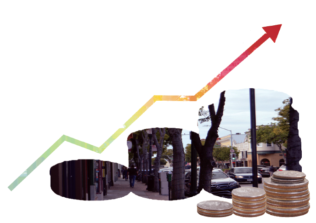

By Emily Xu and Josette Thornhill
“It is not possible to live an independent life on the Peninsula on the minimum wage if you are an adult and want to have your own apartment,” said Rep. Jackie Speier (CA-D). “You would need a subsidized apartment, or you’d need to work two to three jobs and live with someone.”
Conducting business in the Bay Area is expensive and a challenge when the costs of production are on the rise.
As laborers continue to face soaring costs of living and increasingly high rents and real estate prices as a part of the Bay Area Housing Crisis, downtown San Mateo business owners find themselves having to accommodate by providing higher wages.
Senior Eric Cheon‘s family has owned their downtown dry cleaning business Wardrobe Cleaners since 2005 and said that finding employees has been difficult as of late.
“They are often seeking jobs that provide higher pay,” Cheon said. “If [my dad] doesn’t satisfy [his] employees’ needs, they’re gonna want to find other work that can provide a decent payroll.”
Senior Jane Lee’s parents owned a sushi restaurant in San Mateo for ten years before selling it and purchasing a new one in Pacifica.
“[My parents] talked about it being hard to find employees,” said Lee. “They had like eight workers [at their first restaurant], and I remember them slowly starting to fire a couple of them later on before they sold it because they just couldn’t afford everybody.”
Some businesses, in conjunction to rising labor costs, also face rising retail or commercial rent as the economy continues to grow. According to Jennifer Chen, the Economic Development Manager of City Council, retail, commercial, and restaurant rents have all been increasing.
“Mid-pricing restaurants are being hit the hardest,” Chen said. “Olive Garden type of restaurants are being hit very hard because they cost a lot in labor and they have a lot of space and they’re not unique and they’re not special whereas quick service restaurants or food establishments like your tapioca joints and vitality bowls are still growing.”
According to Cheon, an increase in rent amounts to less profit and cash to spend on their business.
“It’s difficult to … keep the business going when the extra income can go towards other needs such as the workers’ pay or towards emergencies,” Cheon said. “To deal with it, my family continues with what they’re doing, [and] maybe spend extra hours, because there’s really no other way but to stick with it … During the summer, [my dad] works longs hours in the heat and rarely goes on vacation because he’s too busy working.”
As costs of production climb, so do costs of services and products businesses provide. For Christopher Zeier, co-owner of downtown San Mateo’s Pasta Pasta restaurant, the driving factor of increased pricing has been labor and ingredient costs rather than rent.
“In the last ten years, we have increased our prices here and there,” Zeier said. “We’re not increasing prices to cover rent. I would say the biggest factor that we raised prices to accommodate arise in labor costs.”
Costs of labor may continue to grow. Speier indicates that California’s minimum wage will likely increase in the future in order to adjust for inflation.

“California’s minimum wage is already higher than the federal minimum [$11 per hour vs. $7.50] and California’s minimum will keep going up for a while,” Speier said. “In any event, it’s not likely that many Peninsula employers are paying the California minimum wage at the moment. It’s just too competitive and employers are already raising wages.”
In San Mateo the minimum wage is projected to go from $13.50 to $15 an hour. Raising minimum wage has its trade-offs, but with the current situation, Economics teacher John Felder said that raising it might be necessary as housing has become expensive in the Bay Area.
“[Raising the minimum wage] puts a big burden on businesses and it causes inflation and so like any policy, it has its cost and its benefits,” he said. “But I think not increasing minimum wage just makes it impossible for low wage earners to even consider affording living costs.”
